Displaying items by tag: SB20
Royal Irish SB20 To Contest French Nationals
Royal Irish Yacht Club sailors Ger Dempsey and Chris Nolan, together with the National Yacht Club's Justin Burke and Flore Dion from Dun Laoghaire will team up to fly the Dublin Bay flag and compete at the SB20 French National Championships in just over a week's time on the Cote D'Azur.
It's a test event before the World Championships next year that will be happening at the same time at the renowned Olympic classes venue at Hyères.
French sailing stars will be joining the event, including two French Youth Teams.
One of the top French sailors, Robin Follin, the 2015 SB20 World Champion and a runner-up in 2018, will be sailing with the same crew: Emeric Michel and Gauthier Germain.
SB20s Cancel Midland Championships Due to 'Fleet Damage'
The SB20 class has cancelled its Midland Championships due to the very low number of boats signed up for this weekend's scheduled event.
Class President Colin Galavan says 'This is due, in part, to damage incurred to some of the boats at the All Ireland Senior Championships'.
Dun Laoghaire-based Galavan told Afloat.ie 'In light of the need to assess and effect repairs to boats and also in light of the small number of entries registered for the event, we have decided to cancel this year's event'.
Meanwhile, the sportsboat class will have an AGM in late November where a schedule of events for 2019 and some new ideas for the coming season will be unveiled.
Peter Kennedy of Strangford Lough Yacht Club has won the 2018 Irish Sailing All Ireland Sailing Championships hosted by Lough Ree Yacht Club, Co. Westmeath today writes Treasa Cox of Irish Sailing.
This prestigious competition, also known as the “Helmsman’s Cup” was first awarded in 1947 and sees sixteen of Ireland’s best sailors battle it out to become the “champion of champions”. Each competitor is nominated by their class, but they all compete in the same type of boat, this year chosen as the SB20.
Peter, who was nominated by the SB20 Class, is a former Olympian sailor who represented Ireland in both Seoul 1998 and Barcelona 1992. This was Peter’s fourth time competing in the All Irelands, and the first time in the finals.
His name now joins the Helmsman’s Cup Trophy alongside other Olympic veterans such as Mark Mansfield and Mark Lyttle.
Final results were Peter Kennedy (Strangford Lough YC) with crew Stephen Kane, and boat owner representative Chris Chapman; in second place were Alex Barry (Royal Cork YC/Monkstown Bay Sailing Club) who represented the RS400s with crew Mel Collins and boat owner representative John McGonigle, and in third place was Ross Kearney representing the GP14s (Royal North of Ireland YC) with crew Jim Hunt and boat owner representative Peter Lee.
Two Sailing Championships to be Decided in End of Season Climax
Irish Times Sailing Correspondent David O'Brien reports in today's newspaper how some of the top crews in the country are in demand this weekend for the All Ireland Sailing Championships on Lough Ree and the J109 Nationals in Howth.
Yesterday, Irish Sailing published the final line up for the All Irelands to be sailed in SB20s that does indeed name some of the top sailors in the country for the 'Champion of Champions' event, as the competition was formerly known.
In Howth, the J109s are lining up for the six-race championships and the forecast is for big breeze. As reported in the Irish Times, although the event has a bar on Category Three Sailing Professionals, there will be no shortage of talented 'amateur' on Howth Sound to try and beat local boat Storm that is aiming for a hat-trick.
Much more in the Irish Times here.
How SB20 'Sin Bin' Prepared for European Championships Success
Michael O'Connor and the Sin Bin crew of Ed Cook and Davy Taylor took third overall and the top Irish result at last week's SB20 European Championships at the Royal Irish Yacht Club. Here, the Royal St. George Yacht Club helmsman, who won the Corinthian World Title in Cowes in 2017, details his campaign preparations that led to bronze medal success on home waters.
Now that the dust has begun to settle after the 2018 SB20 European Championships, I have been asked to put together some notes on our preparation for the event. Everyone approaches these things differently and I am not suggesting that how we prepared was better or worse than any other campaign, this is simply an account of what we did to prepare ourselves as best we could.
It seems to make sense to divide the notes into two separate stages: (1) preparation before the event (sailing and boat preparation); and (2) preparation during the event.
Sailing preparation before the event
Our preparations for the 2018 Europeans began almost two years ago when it was announced that the event was to be held in our home waters of Dublin Bay. On the sailing front, we decided that in addition to the Irish events, we needed to do as many international regattas as we could manage to get more experience racing in larger fleets against high-quality competition. These regattas included the UK Nationals in 2017 and 2018, the Worlds in Cowes in 2017, the Worlds in Tasmania in January 2018 and a regatta in Cascais in April 2018 against high-quality Portuguese, Russian and Ukrainian competition.
 Sin Bin broaches – this photo was after we rounded the weather mark in first place and it dropped us to 7th in that race, our worst result of the day. As a suggested caption “You can do all the practice you want but if you don’t bear off when putting up a kite in 20+ knots…” Alternatively, “to paraphrase Mike Tyson: it’s all very well having a plan in place until you are hit by a gust…” Photo: Anna Zykova
Sin Bin broaches – this photo was after we rounded the weather mark in first place and it dropped us to 7th in that race, our worst result of the day. As a suggested caption “You can do all the practice you want but if you don’t bear off when putting up a kite in 20+ knots…” Alternatively, “to paraphrase Mike Tyson: it’s all very well having a plan in place until you are hit by a gust…” Photo: Anna Zykova
After each major event, we would identify areas that we needed to work on and we would go away and work on those before the next event. For example, after the Worlds in 2017, we were happy with our upwind speed but we felt that the Russian and Australian teams had an edge downwind in heavier winds. Also, we felt that we were “sticky” when lazy planing, that zone between soaking and full planing that the UK teams were so good at… so we went away and worked on those aspects until we felt we were up to speed. At the UK nationals this year, we identified that two UK boats, in particular, were able to sail a little lower than us when planing without losing much distance. This mode can be essential in an asymmetric kite boat to prevent you getting locked out towards the port layline downwind. So we worked on this to develop a lower mode when planing downwind and it proved useful in the Europeans. After the Irish Eastern Championships in early August 2018, the Russian VIS Team (the eventual European Champions) gave the Irish fleet a complete spanking in light airs, they were virtually untouchable, and we have been working on our light air performance since. I guess you could say that it is still a work in progress.
At home, our aim was to sail together as often as possible and at least three times each week. The stories of John Lavery and David O’Brien sailing every morning in Dun Laoghaire before work in 1995 before winning the Fireball World and Europeans are still fresh in the memory and we wanted to emulate their commitment if we could. In addition to DBSC racing on Thursdays and Saturdays which were useful for starting and racing practice, we would train for several hours on Saturday mornings before racing and also on Friday evening or Sunday morning, attempting to improve tacks, gybes and general manoeuvres. One of our team, Ed Cook, started a new job in London at the beginning of this summer so Ed would commute on Wednesday nights/Thursday mornings to make the sailing on Thursday evenings. We didn’t get close to the Lavery/O’Brien commitment levels of sailing every day but we did as much as we could…
 Sheperd them home – This is the last leeward rounding of race 1, from where we lead the Russians and Martin Boatman GBR to the finish to win our first race in an international regatta (we had 2 second places in the Worlds in Cowes, a second place in the Worlds in Tasmania, and a second place in race 3 of the Europeans but we had never won a race at a major event) – we had dropped the kite a little early to be on the safe side and the competition got a lot closer that we would have liked. Here they were about 3-4 boat lengths behind us. Photo: Anna Zykova
Sheperd them home – This is the last leeward rounding of race 1, from where we lead the Russians and Martin Boatman GBR to the finish to win our first race in an international regatta (we had 2 second places in the Worlds in Cowes, a second place in the Worlds in Tasmania, and a second place in race 3 of the Europeans but we had never won a race at a major event) – we had dropped the kite a little early to be on the safe side and the competition got a lot closer that we would have liked. Here they were about 3-4 boat lengths behind us. Photo: Anna Zykova
One area that we have been particularly interested in improving this year is kinetics. From watching the tracker of the Melges Worlds 2016, we could see that the Irish boat Embarr (with Prof O’Connell et al on board) appeared to be consistently lower and faster than their competitors downwind. We then saw a video of Embarr and it was evident that they were sailing the boat far more aggressively than their competitors, using their weight to manhandle the boat downwind. We tried a number of times to get a few sessions in with Prof to work on this, however, we were scuppered by the wind (twice) and busy work schedules, so it is another one to work on in the future. We were however very fortunate to have Shane Hughes of North Sails run a clinic with just ourselves and Broomsticks (IRL 3537 Marty O’Leary, Brian Fenelon, Paddy Kirwan and Rachel Williamson) before the Europeans where we were able to concentrate on and really improve this area of our sailing.
 Training partners fighting it out on the course…this shows us going downwind with our training partner, Broomsticks (Marty O’Leary et al), with the red kite in the foreground. I believe that this is from race 3 where we came second and Broomsticks were third Photo: Anna Zykova
Training partners fighting it out on the course…this shows us going downwind with our training partner, Broomsticks (Marty O’Leary et al), with the red kite in the foreground. I believe that this is from race 3 where we came second and Broomsticks were third Photo: Anna Zykova
Boat preparation before the event
In addition to the sailing preparation, boat preparation has been a massive part of the campaign. All of the work on our hull and keel is done exclusively by Edwin Brennan. Edwin is a perfectionist and in my opinion, his work is second to none. I always say to anyone that needs to get work done on their boat, if you want it to be perfect, get Edwin to do it. We were fortunate to get the loan of a 1720 trailer from Ronan Adams in the Royal St George Yacht Club in the lead up to the Europeans and Edwin was able to repair some recently acquired deep scratches in the keel bulb and fin and respray the entire keel before the event so that it was exactly how we wanted it.
 This was from race 3 (we were second pretty much all the way around and here we are chasing down John Pollard, the UK National Champion) - you can see the pain in our faces – from left to right O'Connor, Taylor and Cook Photo: Anna Zykova
This was from race 3 (we were second pretty much all the way around and here we are chasing down John Pollard, the UK National Champion) - you can see the pain in our faces – from left to right O'Connor, Taylor and Cook Photo: Anna Zykova
In addition to the hull, a lot of work went into perfecting the systems. This area is definitely not my forte, however, I have been blessed to sail with two guys, Davy Taylor and Ed Cook, who it seems live for this stuff! Davy, in particular, knows SB20s like the back of his hand and Ed has a great analytical mind to solve the tricky problems. Over the last 12 months, Davy and Ed have been keeping a close eye on other boats in the fleet to see what everyone else is up to and to see if we can learn from them and improve our systems in any way, as well as coming up with their own ways to improve our systems. This might mean that we can lose a couple of ounces on a shackle or a fitting somewhere, or we can speed up our spinny hoists by reconfiguring the retrieval line. Together, they have “turboed” Sin Bin to within an inch of her life!
Everything on the boat works and if we think something might need replacing, it is replaced straight away. When the boat came back from Tasmania in March of this year, we removed all of the fittings from the hull and ran a dehumidifier in the boat for several weeks to dry the boat out fully. Thereafter, we sealed and reattached all of the fittings, replaced any tired fittings, and beefed up certain fixtures like the traveller cleats so that we could roll tack more aggressively in light airs.
In relation to sails, we don’t have a choice of sail manufacturer in the SB20 fleet as this is chosen by the supplier, however, we had a new main, jib (x2) and spinny for the Europeans. We took both jibs out the weekend before the event to shake them out and we chose the one that we felt looked better for the conditions.
Preparation during the event
Every morning of the event, we would meet at 9 am for 20 minutes in Barry O’Neill’s penthouse apartment overlooking Dublin Bay. There, we would have a great view of the wind moving across the bay. Barry is a former Olympian (in the Flying Dutchman class) and I had the privilege of sailing with Barry for many years in J24s. Barry has spent the last 40 years sailing in Dublin Bay and I cannot think of anyone who knows the tides and winds of Dublin Bay better than Barry (Barry also sold me Sin Bin in 2015 so he knows SB20s too!). Each morning, Ed, Davy and I would sit down over a coffee with Barry and discuss the forecast for the day, the likely area of the race course (Barry now does a lot of race officer work in Dublin Bay so he has great insight into what might happen from a race management perspective) and the tidal effects on the race course throughout the day. This routine was invaluable as it got our minds focused on the day ahead.
For the tides, we had printed out (on A4 sheets that were then laminated) screenshots from the Dublin Bay tidal atlas at 0.5-hour intervals. For the forecasts, we used Weather4D with Arome HD forecasting models as recommended by Shane Hughes of North Sails. We found the accuracy of the Arome HD excellent and I believe it provided better granularity than other forecasting models.
 From day 2, race 1 - We were leading the Russians VIS 3707 (eventually winners) into the weather mark here – they are the black boat on starboard. You can also see the Portuguese national champion, Vasco Serpa, coming up on starboard to weather of the Russians. (Vasco was 7th in the Atlanta Olympics in the Laser). We were eventually passed out by the Russians at the end of the second run. Photo: Anna Zykova
From day 2, race 1 - We were leading the Russians VIS 3707 (eventually winners) into the weather mark here – they are the black boat on starboard. You can also see the Portuguese national champion, Vasco Serpa, coming up on starboard to weather of the Russians. (Vasco was 7th in the Atlanta Olympics in the Laser). We were eventually passed out by the Russians at the end of the second run. Photo: Anna Zykova
We would make our way down to the club for 9.30am to get changed, dive the hull (the boats had to stay in the water for the duration of the regatta with keels down - we put the boat into the water as late as possible on Monday afternoon so Davy dove on Thursday morning and Saturday morning only), prep the rig for the expected conditions (I like to take a bit of time to prep the rig myself so often I will do that first while the lads get changed) and rig the boat, ready to leave the dock at 10.30am, 1.5 hours before the start of the first race.
We had arranged in advance of the event that Broomsticks (Marty O’Leary et al) would be our training partner so we would typically have a chat with the Broomsticks team before leaving the dock about the forecasts that we had both seen, what rig settings we were both going for, what we expected the wind to do etc. we always ensured that we were rafted up beside each other so that we could get a quick getaway each morning.
We would leave the dock with Broomsticks at 10.30am, make our way out to the race area and then do some pacing with them until we were both happy that we knew our likely kicker, outhaul, backstay, jib cunningham etc. settings for the prevailing conditions and to obtain some compass headings for each tack. Then, we would do a couple of practice beats, one of us heading out to the right side of the course, the other boat heading out to the left for four minutes before tacking, checking to see who crossed ahead and whether there was a major advantage to one side of the course or the other. We would then go downwind, get some compass headings for the downwind legs and discuss what we had seen, whether we thought the boat was leading after the beat due to a shift/tide, and if something happened that was unexpected. I think pairing up with a training partner really helped both teams during the event as again, it put some structure on the day and got us focused on the job ahead.
 This is us crossing the finish line on the last (fourth) race on day four, our second bullet of the day. We were absolutely shattered and we knew we were close to the start line on a black flag so there was relief mixed with jubilation when we heard the gun. Unscripted, we all punched the air simultaneously. Photo: Anna Zykova
This is us crossing the finish line on the last (fourth) race on day four, our second bullet of the day. We were absolutely shattered and we knew we were close to the start line on a black flag so there was relief mixed with jubilation when we heard the gun. Unscripted, we all punched the air simultaneously. Photo: Anna Zykova
About 20 minutes before the start, we would split off from Broomsticks and do our own thing, look at the wind coming down the course, discuss our likely strategy for the race ahead. We would “ping” the ends of the line with the Velocitek and then we would run along the line to make sure that the Velocitek was accurate and we would determine the favoured end of the line. Every so often, we would do a quick wind reading to see what phase the wind was in. We would have decided by c.3.5 minutes before the start where we are going to start and we would make our way towards the end of the line that we had chosen and line up for the start. After the race, we would typically have a quick chat about what worked, what didn’t work and what happened in the previous race and if we can use any of what we had learnt in the next race. Once ashore, we would take any tension off the rig before enjoying a well-deserved pint. Rinse and repeat!
Bronze Medal for O'Connor's Royal St. George 'Sinbin' Crew at SB20 Europeans
A final race win for Royal St. George's Michael O'Connor, the 2017 SB20 Corinthian World Champion, allowed him to produce the goods again for Ireland, this time on home waters, by taking third overall at the SB20 European Championships 2018 sailed at the Royal Irish Yacht Club.
O'Connor, sailing with Davy Taylor and Edward Cook, finished 20–points off the lead after ten races sailed and two discards on Saturday.
O'Connor was one of three Irish boats in the top ten of the 47-boat fleet that was dominated by the Russian Vis sailing team entry of Artem Basalkin, Timur Sabirzianov and Alexander Mikhailov of Saint-Petersburg. In eighth place was Marty O'Leary sailing 'Broomsticks' and in tenth overall was Stefan Hyde's 'Bád' team.
Full results here
SB20s Ready to Race After Sailing Scrubbed Yesterday on Dublin Bay
Yesterday's racing in the SB20 Europeans on Dublin Bay may have been a casualty to light winds but this morning's 20–knots from the south should more than provide a thrilling day's racing for the 47-boat fleet drawn from ten nations.
Irish hopes this morning are led by Stefan Hyde of the Royal Irish Yacht Club hosts in fourth overall after five races sailed. See Afloat.ie's report here.
Stefan Hyde Moves Up to 4th at SB20 Euros at Royal Irish Yacht Club
After five races sailed at the SB20 Europeans Irish entry 'Bad/Kilcullen' crewed by Stefan Hyde, Jerry and James Dowling are up fourth overall at the Royal Irish Yacht Club hosted event and are just 13–points off the overall lead.
After another three races sailed yesterday, the host club boat that leads Irish hopes on Dublin Bay moved up seven places after discard. Hyde's Bad Kilcullen has been in form this season on the Irish circuit winning the first regional event of the season at Greystones Harbour.
A second Irish boat from the 22 competing is also in the top ten overall this morning with 'Sin Bin' sailed by Michael O'Connor, Davy Taylor and Edward Cook of the Royal St George Yacht Club in sixth position.
Irish boats represent 40% of the 47-boat fleet that is drawn from ten nations.
The overall lead is now held by Australian's Porco Rosso, Elliott Noye, Paul McCartney and Edward Snowball on 20 points. Second is Ukranian entry 'itParfum Borys' Shvets Anatolii Petrov, Pavlo Matsuyev and Anna Kyselova Odessa Sailing Club with Royal Torbay Yacht Club's Xcellent John Pollard, Steve Procter and Jack Wetherell in third place.
Full results after five races here
Racing continues today.
Ger Dempsey of the host club is the top Irish boat of 22 home entries in an international fleet of 47 after two races sailed at the SB20 European Championships at the Royal Irish Yacht Club yesterday.
Russia's Victoria Sailing Team of Vadim Pushev, Ivan Gromov and Aleksey Kolobanov lead overall from Australia's Porco Rosso, Elliott Noye, Paul McCartney and Edward Snowball. Third overall is RUS3708 Melston Team Kirill Frolov, Egor Ignatenko and Egor from Terpigorev Yacht Club from Saint-Petersburg.
Dempsey sailing with Chris Nolan, Rory Groves and Tim Norwood is seventh overall and three places ahead of Howth Yacht Club entry Binn Eadir sailed by Cillian Dickson, Sam O'Byrne Gordon Stirling and Diana Kissane in tenth place.
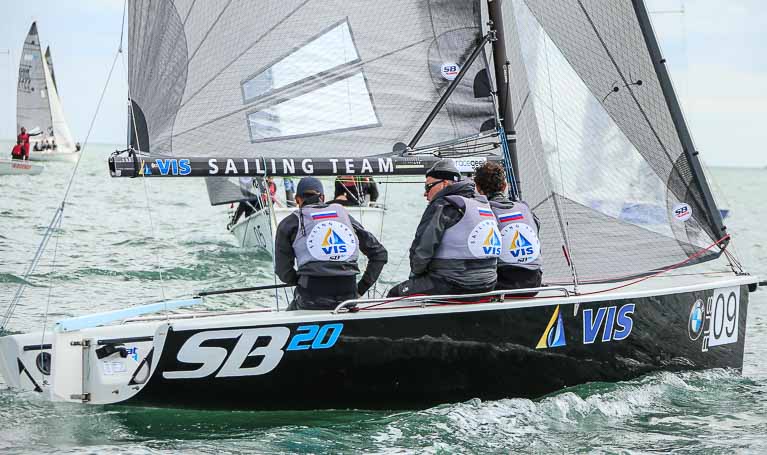 Overall leaders Russia's Victoria Sailing Team of Vadim Pushev, Ivan Gromov and Aleksey Kolobanov Photo: Afloat.ie
Overall leaders Russia's Victoria Sailing Team of Vadim Pushev, Ivan Gromov and Aleksey Kolobanov Photo: Afloat.ie
Three races were scheduled but just two sailed under International Race Officer Jack Roy in some very variable southwesterly winds on Dublin Bay.
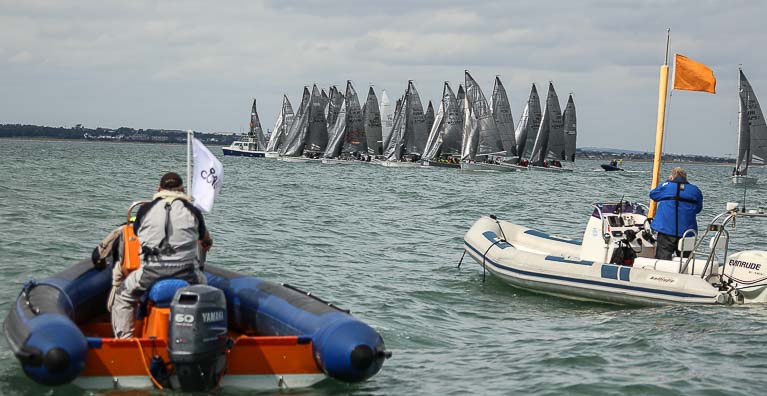 This race two start (above) was abandoned but the one (below) got away under the 'U flag' Photo: Afloat.ie
This race two start (above) was abandoned but the one (below) got away under the 'U flag' Photo: Afloat.ie
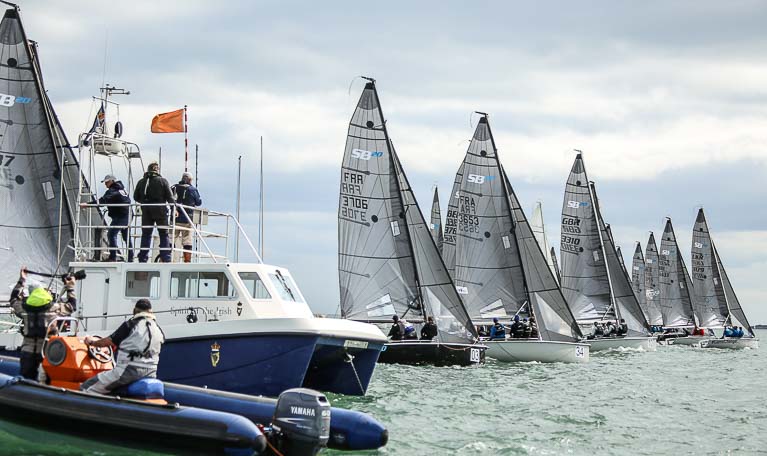
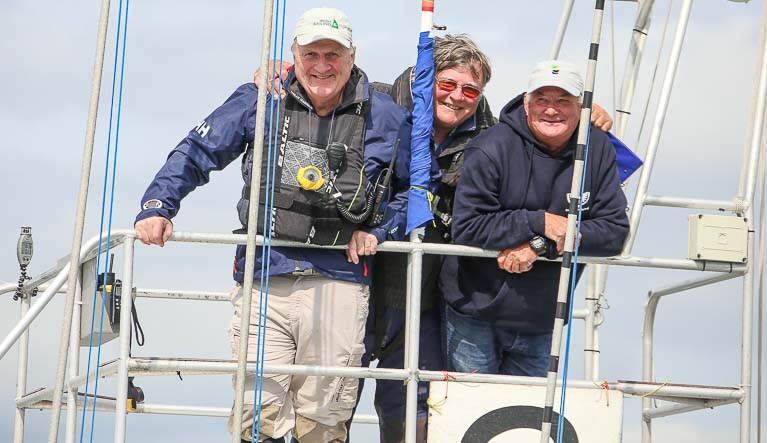 Race Officer Jack Roy (left) with RIYC's Peter Fleming (centre) and John 'Hammer' Veale Photo: Afloat.ie
Race Officer Jack Roy (left) with RIYC's Peter Fleming (centre) and John 'Hammer' Veale Photo: Afloat.ie
Full results are here
Racing continues today.
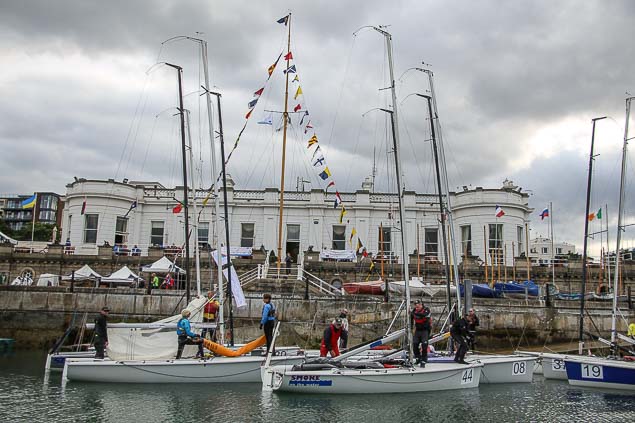 SB20s raft up at the RIYC Photo: Afloat.ie
SB20s raft up at the RIYC Photo: Afloat.ie
SB20 Crews Arrive for Euros at Royal Irish Yacht Club
Many of the international teams have now arrived in Dublin for the SB20 European Championships at the Royal Irish Yacht Club from Tuesday 28th August to Saturday 1st September. Racegeek's Ric Morris, one of the event sponsors, runs through the likely contenders for next weeks SB20 Europeans
VIS Sailing Team of Saint-Petersburg announced their intentions with a win at last week’s East Coast Domestic Regionals, dominating the final day of racing with 3 wins out of 4.
Equipment for the Australian Porco Rosso team arrived at the venue last night and the team arrives this Friday. Their second-place finish at the recent Portuguese Nationals marks them out among the favourites. The Portuguese team Animal of Clube Naval de Cascais that won that event is also here in Dublin.
Michael O'Connor’s Sixth Place is Irish High
Multi-world champions Give Me 5 are absent, but a strong French contingent of 5 teams is led by Alain Roig. Ukrainian team #GAMECHANGER is also expected to mount a challenge.
The SB20 class has had a strong presence in Ireland since its inception and any of four local teams can be expected to be in the mix. Despite patchy form since Michael O'Connor’s 6th place at the 2017 World Championships remains the stand out performance by an Irish team at the top level.
Jerry Downing and Stefan Hyde of host club have won the national championship several times. No big event in Ireland would be the same without Marty O'Leary and after a couple of seasons dominating the RS200 racing nationally he switches over to helm Boomsticks for this event. A Howth Yacht Club team with Cillian Dixon and Sam Byrne as regulars joined the class this winter and will be strong contenders.
After 3 months of sunny and stable weather, Autumnal equinox conditions arrived in Dublin last week. The first day of the east coast championship served up winds pushing past 35 kts. It's a testament to the resilience of the SB20, and the suitability of the venue for sportsboat racing, that racing continued in conditions that may otherwise have been of concern. Dublin bay can be a tricky venue with a strong tidal influence and the long-range forecast indicates there is the potential for similar full-on racing next week.
Racegeek is one of a number of sponsors for the event. The company has been associated with the class previously as a sponsor of the 2017 Worlds in Cowes, England and 2018 Worlds in Hobart Australia.
More on Racegeek here

































































